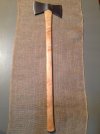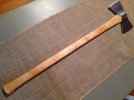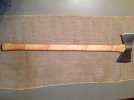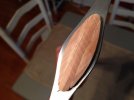Well, apply pressure and get a break at the weakest point - how profound. Of course, anything will break at the weakest point. The 1914 article is difficult to say the least. Maybe partly because of the manner of speaking a century ago. The terminology is not well defined. However, I read the article as defining a break attributed to compression as a specific type of break that happens when two distinct events occur sequentially. The first event is the creation of a significant weak spot from a side impact or naturally caused in the growing tree. The second event is when the wood is so weakened (from the first event) that it breaks under pressure (regardless of the direction of the pressure) at that weak spot.
Post #32:
I read this as "compression injuries" are exactly equal to "compression failures". If this is what your definition is, what term can be used to define the week spot in the wood resulting from some trauma (before an actual break from pressure)?
Just to be precise here is the entire first sentence:
"When too great a pressure is applied to struts or columns of wood in the direction of the grain, the fibers bend or buckle at the weakest point, resulting in a streak or wrinkle on the face of the material, which is an indication of a compression failure (see figure 1)."
I honestly am not sure what I'm looking at in fig 1 above. I guess item one is yellow pine flooring with compression failure. Not sure what the sequence of events were that caused that.
Of course not. It would be silly to believe that, but I do believe science has sure changed a hell of a lot.
Again, are "compression failures" exactly equal to "defects". If these terms are equal, what term can be used to define the week spot in the wood resulting from some trauma (before an actual break from pressure)? A piece of wood with a weak spot is not necessarily a broken piece of wood. The author refers to the weak spots as "failure zones". The whole sentence partially quoted above: "The failure zones are regions where the cells have been permanently deformed or fractured by excessive compression forces parallel to the grain.". Actual fracture is not attributed in that paragraph to pressure direction.
Here is the paragraph cited:
Meets the "definition" of what? The 2012 source does not mention anything about "in the direction of the grain". "in the direction of the grain" is implied in the 1914 source with the buggy spokes. I suppose if you drive a spoke in until it bottoms out, and keep on beating it enough, bad things will happen. The author says this happens "occasionally", but does he know for a fact that these spokes developed a weak spot attributable to only exact hits perpendicular to the end grain by the spoke pounder? I see no evidence in that article to indicate that the author knew exactly where the weak spots came from.
My take (YMMV) on axe handles and defects.
Supposedly these weak spots that can lead to "compression failure" in wood can be seen or not seen. If one can be seen in a piece of wood, then simply don't use it as is. If it can't be seen, then for all practical purposes, it doesn't exist. Sure after some use a handle may break and it is a possibility that it had the type of hidden defect that would classify it as a "compression failure", but the bottom line is, you just go get another handle. As far as fitting a handle, if you have one without visible defects and is straight grained (read no runout), pound and fit as much as necessary and get a good hang.
If you believe that "excessive pounding" is worth worrying about why not conduct a controlled scientific experiment? I'm thinking along these lines:
- Clearly and unambiguously state the objective
- Obtain a few hundred or so handles
- Inspect the handles to insure no hidden defects are present
- Test them on an appropriate machine
- Publish and get the results peer reviewed by members of the scientific community
- Report back here
Bob







